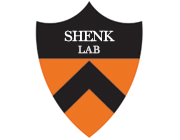Research Focus: Human Cytomegalovirus Replication and Pathogenesis
Cytomegaloviruses are members of the herpes virus family. Human cytomegalovirus (HCMV) infections are widespread and subclinical in the vast majority of cases, but the virus exhibits increased virulence in the very young and old and in immunocompromised individuals. Congenital infections cause life-long disabilities in a significant number of children. Transplant recipients, cancer patients, and AIDS patients, all of whom can exhibit decreased immune function, suffer a variety of clinical manifestations resulting from cytomegalovirus infection, including mononucleosis and pneumonia. There are also suggestions in the literature that HCMV might serve as a cofactor in certain cancers, atherosclerosis and immune senescence. The HCMV particle carries a viral genome comprised of linear double-stranded DNA that encodes more than 200 proteins, 23 microRNAs and a variety of additional non-coding RNAs. We study molecular mechanisms underlying HCMV replication and pathogenesis.
When the virus infects a fibroblast, epithelial cell or endothelial cell, it actively replicates and generates infectious progeny. We have studied the HCMV life cycle by using a mixture of genetic, biochemical, proteomic and metabolomic approaches. One area of special interest to us has been the identification of mechanisms by which the virus blocks defensive responses of the host cell, an area where the HCMV pUL38 protein plays a major role. We constructed a mutant virus unable to express pUL38 and found that it failed to efficiently express all viral genes tested and infected cells died of apoptosis before the viral replication cycle was completed. Using proteomic technology we discovered that pUL38 binds to the cellular tuberous sclerosis protein complex (TSC). This is a tumor suppressor complex that interprets stress signals and modulates the activity of mTOR, which in turn controls translation, fatty acid synthesis and many other vital processes in the cell. The pUL38 protein blocks the ability of TSC to respond to upstream signals, allowing the virus to continue to utilize cellular biosynthetic systems in spite of inducing a strong stress response. We have further probed the HCMV-host cell interaction by studying how metabolism is altered by infection. This work has revealed that HCMV induces glycolysis, nucleotide synthesis, citric acid cycle flux and lipid biosynthesis. Inhibition of the committed step of fatty acid synthesis and elongation, acetyl-CoA carboxylase, blocks HCMV replication, so we performed an siRNA screen and identified a substantial number of enzymes that sponsor fatty acid and lipid biosynthesis and are needed for successful virus replication. We are now working to elucidate how these enzymes are regulated, and one approach we have employed is to knock down each of the cell-coded kinases and test how the loss of function influences HCMV replication. This approach has identified several kinases that modulate the cell metabolome following infection. Most recently, we discovered that each of the seven human sirtuins is an HCMV restriction factor. Sirtuins are NAD+-dependent protein deacetylases, and we have begun to identify cellular targets of sirtuins that are critical for their anti-viral activity.
When HCMV infects a bone marrow stem cell or a monocyte, it doesn't replicate. Rather, it enters a state of quiescence termed latency. We have developed and validated two cell culture models for latency. Using these models, we have discovered that the virus transiently expresses a large number of viral products after infecting these cells, but after several days the viral genome becomes quiescent. A small number of viral proteins that continue to be expressed, including pUL138, a protein whose role in latency was first identified in our latency models. Others have shown that it controls the expression of at least one cell surface protein, and we are now following this clue by characterizing the cell surface proteome of uninfected monocytes as compared to monocytes harbouring latent HCMV. Our early results show that they are remarkably different!
Recent Publications
Contact
Shenk Lab
203 Thomas Laboratory
Department of Molecular Biology
Princeton University
p 609-258-5993
Faculty Assistant
Tammy Griffin
[email protected]
p 609-258-1694
Shenk Lab Website
molbiolabs.princeton.edu/shenk

